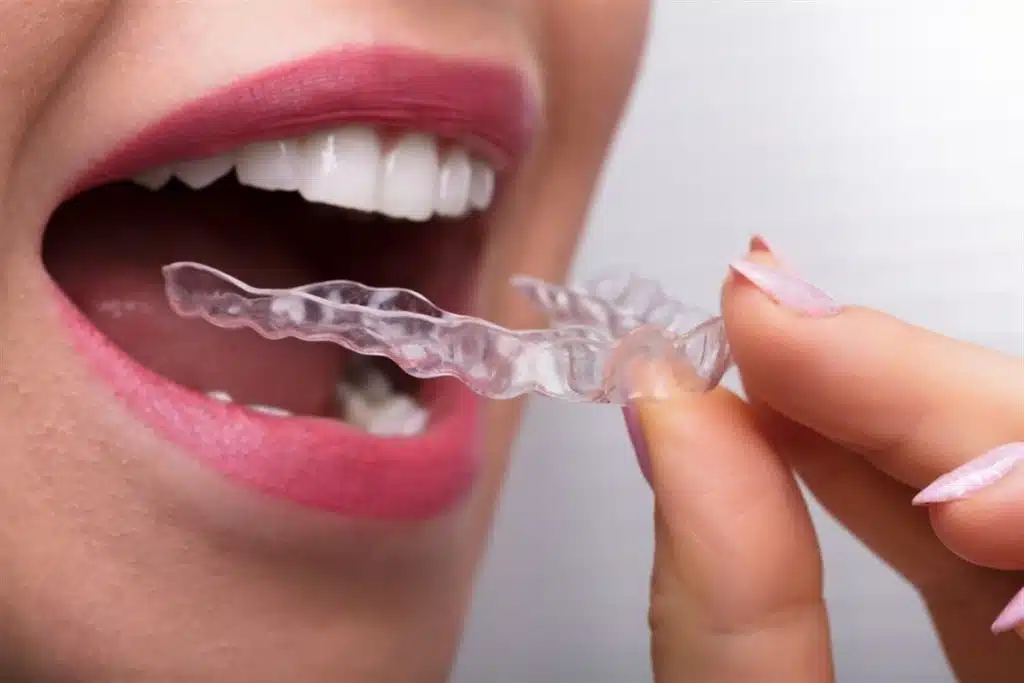Can Invisalign Fix Overbite, Underbite & Crossbite? What’s Possible Now

Bite problems like overbite, underbite, and crossbite aren’t just cosmetic. They can affect how you eat, speak, and even breathe. With clear aligners becoming more popular, many people ask: can Invisalign fix overbite and similar alignment issues? The answer depends on the type of bite and the severity, but treatment options today are more advanced than ever. Here’s what you should know before considering Invisalign for bite correction.
Understanding Bite Problems
Not all bite issues are the same. Each one affects the alignment of your teeth and jaws differently, and that impacts the type of treatment needed. Here’s a breakdown of the most common types:
What Is an Overbite?
An overbite happens when the upper front teeth stick out too far over the lower teeth. Some overbite is normal, but too much can cause jaw strain, speech problems, or wear on your teeth.
Common causes include:
-
Genetics (jaw size or shape)
-
Childhood habits (thumb-sucking, pacifier use)
-
Teeth grinding or clenching
What Is an Underbite?
With an underbite, the lower teeth sit in front of the upper teeth when you bite down. It can make chewing difficult and may cause jaw pain over time. Underbites are often more noticeable and may be linked to jaw development rather than just teeth alignment.
What Is a Crossbite?
A crossbite means some of the upper teeth sit inside the lower teeth when your mouth is closed. It can affect the front or back teeth. Left untreated, crossbites can lead to uneven tooth wear, gum problems, or even facial asymmetry.
Quick Comparison of Bite Issues
| Bite Type | How It Looks | Potential Issues |
|---|---|---|
| Overbite | Top teeth extend far over lower teeth | Jaw strain, tooth wear, speech issues |
| Underbite | Lower teeth extend past upper teeth | Chewing problems, jaw pain |
| Crossbite | Top and bottom teeth don’t align properly | Gum damage, uneven wear, bite stress |
Understanding what type of bite you have is the first step in finding the right solution. Invisalign may be one of them, especially for mild to moderate cases.
Can Invisalign Fix Overbite and Other Bite Issues?
Many patients want to know: can Invisalign fix overbite and other common bite problems like underbite or crossbite? The answer is yes—in many cases. Invisalign has evolved over the years and is now capable of addressing more than just crooked teeth.
How Invisalign Works
Invisalign uses a series of clear aligners that gradually move your teeth into better positions. These aligners are custom-made and replaced every 1–2 weeks to keep up with your progress.
Here’s what makes Invisalign effective for bite correction:
-
Precise planning with 3D imaging technology
-
Attachments placed on teeth to guide movement
-
Elastic bands for jaw alignment, if needed
-
Predictable progress with regular monitoring
Invisalign doesn’t just move teeth—it can influence jaw alignment as well, especially in younger patients or in less severe cases.
What Can Invisalign Treat?
Invisalign works well for bite issues that are mild to moderate. Here’s how it handles each one:
-
Overbite: Invisalign can shift upper and lower teeth into better alignment. Elastics may be used to adjust jaw position. This is one of the most commonly treated bite problems with aligners.
-
Underbite: If the underbite is caused by teeth rather than jaw shape, Invisalign can move them back into a healthier position. Jaw-related cases may need more than aligners.
-
Crossbite: Invisalign can help reposition upper and lower teeth so they meet correctly. This often involves adding attachments to guide movement more precisely.
Invisalign vs. Traditional Braces for Bites
| Feature | Invisalign | Braces |
|---|---|---|
| Appearance | Clear and removable | Metal or ceramic brackets |
| Comfort | Smooth plastic trays | Brackets and wires |
| Bite Correction Capabilities | Good for mild/moderate cases | Better for severe misalignments |
| Maintenance | Remove to eat and clean | Brushing around brackets needed |
Invisalign is not a one-size-fits-all option, but for many people asking can Invisalign fix overbite, the answer is yes—with the right diagnosis and consistent wear. Your orthodontist will determine if aligners alone can do the job or if extra tools like elastics or limited braces are needed for support.
Who Is a Good Candidate for Invisalign Bite Correction?
Not everyone is a fit for clear aligners when it comes to fixing bite problems. If you’re asking, can Invisalign fix overbite for someone like you, it comes down to the details of your case.
When Invisalign Works Well
Invisalign is often a strong option for:
-
Mild to moderate overbites
-
Dental underbites (caused by tooth position, not jaw size)
-
Crossbites involving a few teeth
-
Teens and adults with fully developed jaws
-
Patients looking for a discreet treatment
Most Invisalign cases also require good oral hygiene habits and a willingness to wear the aligners at least 20–22 hours per day.
When Braces or Other Options May Be Better
Some bite issues are too complex for Invisalign alone. These include:
-
Severe overbites or underbites caused by bone structure
-
Cases needing jaw surgery or palatal expansion
-
Patients who won’t consistently wear aligners
In those situations, braces, jaw devices, or even a combination of treatments may be more effective.
How to Know If Invisalign Could Work for You
Here are some signs Invisalign may help:
-
Your dentist has mentioned a bite concern, but not jaw surgery
-
You want a less visible solution
-
Your bite issues aren’t causing significant jaw pain or speech problems
-
You’re able to follow daily wear instructions
The best way to find out is through an orthodontic evaluation. During that visit, your provider can scan your bite and answer directly: can Invisalign fix overbite for your specific case?
Real Results: What’s Possible Now With Invisalign
As technology improves, so do the results patients can expect. Many people who once needed braces now have successful outcomes with Invisalign. If you’ve been asking can Invisalign fix overbite or similar concerns, it’s helpful to see what’s achievable today.
Technology Behind the Progress
Modern Invisalign treatment uses features that weren’t available a decade ago:
-
SmartTrack material: This flexible yet firm plastic improves comfort and control.
-
Precision wings: Designed for younger patients, these help guide jaw movement during overbite correction.
-
3D treatment planning: Doctors can map each step of your tooth movement from day one.
-
Tooth-colored attachments: These allow for more complex movements without affecting the look of your smile.
With these advancements, aligners are now able to treat a broader range of bite problems than ever before.
What You Can Expect From Treatment
The results you get depend on the starting point and how well you follow instructions. That said, here are some typical outcomes:
-
Straighter teeth with better bite function
-
Reduced jaw discomfort or strain
-
Easier brushing and flossing due to improved alignment
-
A more confident and natural smile
Treatment timeline for bite correction with Invisalign:
-
Mild cases: around 12–15 months
-
Moderate cases: closer to 18–24 months
-
Retention phase: ongoing, with retainers worn at night
Invisalign Treatment at a Glance
| Factor | Typical Range |
|---|---|
| Treatment time | 12–24 months |
| Aligner wear per day | 20–22 hours |
| Dental visits | Every 6–8 weeks |
| Retainer use (post-treatment) | Nightly for long-term results |
When patients ask can Invisalign fix overbite and bring in real expectations, the answer is often yes—especially when treatment is guided by an experienced provider using the latest tools.
FAQs About Invisalign and Bite Correction
Patients often have questions about how Invisalign works for bite issues. Below are some of the most common ones—clear and to the point.
Can Invisalign fix overbite in teens and adults?
Yes, Invisalign can fix overbite for both teens and adults in many mild to moderate cases. Teen aligners may include special features like mandibular advancement wings to help guide jaw growth. Adults benefit from the same technology, though results depend on bone structure and case complexity. A full orthodontic evaluation is the only way to know for sure.
How long does it take to fix a bite with Invisalign?
Most bite corrections with Invisalign take between 12 and 24 months. The exact timeline depends on how severe the bite is and how closely you follow the wear schedule. Skipping days or not wearing the aligners long enough each day can delay results.
Is Invisalign painful when correcting bite problems?
Mild pressure and soreness are common during the first few days of each new aligner set. This usually fades quickly. Invisalign is generally more comfortable than braces because there are no metal brackets or wires causing irritation.
What if my bite problem is too severe for Invisalign?
If the bite issue is skeletal or involves major jaw misalignment, Invisalign alone may not be enough. Your orthodontist might suggest braces, jaw appliances, or a combination approach. In some cases, surgical correction may be necessary before or after orthodontic treatment.
Do I have to wear retainers after Invisalign?
Yes. Retainers keep your teeth in place after treatment. Without them, your bite can shift back over time. Most patients wear retainers every night to maintain their results long term. Your orthodontist will guide you on how often and how long to wear them.
Final Thoughts
Bite problems like overbite, underbite, and crossbite can affect more than just appearance—they can impact comfort, speech, and long-term oral health. Thanks to advancements in clear aligner technology, many patients no longer need metal braces to correct these issues.
So, can Invisalign fix overbite and other bite concerns? In many cases, yes. With the right diagnosis and a commitment to wearing the aligners as directed, you could see noticeable improvements in both function and aesthetics.
Still, not every bite is the same. The only way to know what Invisalign can do for you is to speak with a provider who understands both the technology and your individual needs. It’s a decision worth exploring—for your health, your confidence, and your future smile.
Start Your Personalized Invisalign Assessment with Dr. Lints Orthodontics
If you’re wondering about bite correction options, now is the time to take action. Our experienced team offers complete evaluations to determine if Invisalign or braces can help improve your overbite, underbite, or crossbite.
At Dr. Lints Orthodontics, you’ll work directly with a board-certified orthodontist in Traverse City who has decades of experience creating customized treatment plans. As a Diamond Invisalign Provider, Dr. Lints offers expert care for those considering Invisalign in Traverse City—and for patients who may benefit more from braces in Traverse City, we provide those options as well.
Schedule your consultation today and take the next step toward a healthier, more confident smile.
GETTING STARTED WITH INVISALIGN
If Invisalign sounds like it is the right fit for you, call or text us to set up a complimentary consultation. During this consultation, Dr. Lints and team will:
- 1. Review your dental and medical history
- 2. Perform a complete oral exam
- 3. Help you determine if Invisalign is the best route for you
- 4. Create you a customized treatment plan with before and after simulation
- 5. Discuss flexible payment plan options and insurance benefits if applicable



